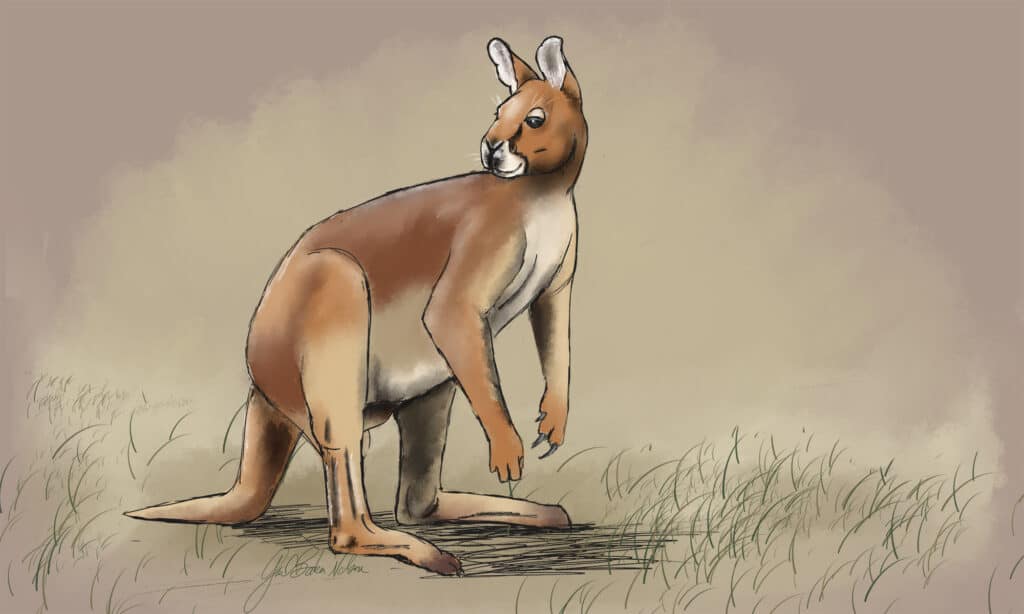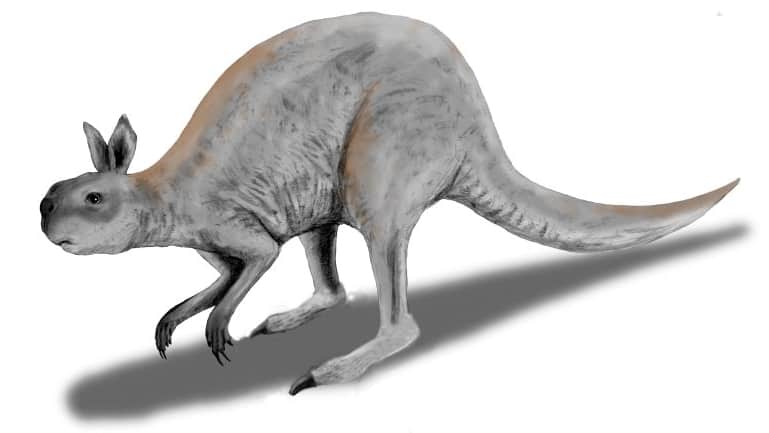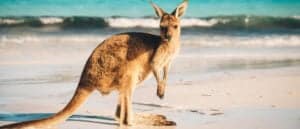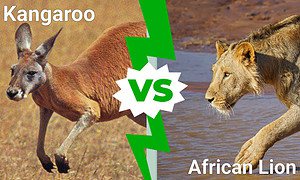What would you do if you saw a kangaroo that towered over you? That could have been a possibility if you lived in the Pleistocene Epoch, which ranges from 11,700 to 2,580,000 years ago. The scientific name of the largest procoptodon is Procoptodon goliah. There were also several other types of procoptodons that were slightly smaller. Procoptodons lived at the same time as modern kangaroo species, but they died out sometime between 18,000 and 45,000, while modern kangaroo species remained.
Description and Size
Procoptodon goliah measured at least 10 feet from the tip of its tail to its nose. When standing, they were between six and nearly nine feet tall. They weighed between 440 and 530 pounds. By these measures, the largest procoptodons could be more than three times larger than modern kangaroos. In profile, procoptodons had a similar body shape to what we know as kangaroos. However, their faces were flat and they had forward-facing eyes, indicating they were predators. This is opposed to the modern kangaroo’s pointed face with a wide field of vision but with eyes more on the sides of their head.
Procoptodons also differed from modern kangaroos by their paws. Their hind paws or “feet” consisted of just one large toe and claw. Their front paws, or their “hands”, had just two large curved claws. Modern kangaroos have four toes on their hind paws. The two middle toes are fused together with two smaller ones on each side. Modern kangaroo front paws have five toes, each with long claws.

What Did Procoptodons Eat?
Researchers are not 100% sure which plants procoptodons ate, but they know they were herbivores. They likely ate a diet of grasses and shrubs. Experts believe that the shapes of their faces and molars were best suited to eat grasses and that they were likely grazing animals. They also believe that their leg shape allowed them to travel over moderate distances to find appropriate sources of water for drinking and to get the proper salt intake.
The level of enamel in their teeth suggests that they drank water directly from rivers, lakes, or streams, instead of getting hydration through the plant materials they ate.
Habitat: Where and When Procoptodons Lived
Procoptodons lived in Australia, mainly in what is now South Australia and New South Wales. At the time, this area would have had very few trees, and consisted mostly of sand dunes. Lake Menindee is also found in this area. At the time, it would have been surrounded by plains, forests, and savannah. At the time, it could have been an oasis for the procoptodons.
Procoptodons lived during the Pleistocene era. Many experts believe they went extinct around 45,000 years ago, but there is some evidence that they may have been around as recent as 18,000 years ago.
Procoptodon Threats and Predators
Experts believe that one of the greatest predators of procoptodons may have been humans. However, there isn’t any archaeological evidence of humans eating them. Despite that, experts believe that their large size would make them more easily visible to humans in grasslands. Based on their anatomy, they were also likely walkers, not fast hoppers like today’s kangaroos. So, they may not have been able to outrun humans.
Experts also believe that human activity, in general, was a threat to the procoptodon’s food sources.
Other predators likely included the Thylacoleo, AKA the marsupial lion, and Varanus priscus, a giant monitor lizard. Some experts believe that procoptodons may have defended themselves similar to kangaroos today. They may have balanced on their tails to kick predators with their strong legs.
Discoveries and Fossils: Where Was it Found?
Nearly 65 procoptodon fossil specimens have been found in Australia:
- 4 in the state of Western Australia
- 30 in the state of South Australia
- 6 in the state of Victoria
- 12 in the state of New South Wales
- 12 in the southern part of the state of Queensland
The first procoptodon skeleton was found in 1874 and the species was named by Richard Owens, a British biologist, and paleontologist.

Based on the shape of their faces and molars, scientists believe that procoptodons were grazers.
©Nobu Tamura / CC BY 3.0 – License
Extinction: When and Why Did Procoptodon Die Out?
Procoptodons went extinct somewhere between 18,000 and 45,000 years ago. Experts aren’t sure exactly why they went extinct, but they have a few theories. Many believe that it is a combination of these theories that ultimately led to their demise.
Human Behavior
While experts don’t think that hunting could have totally killed off such a plentiful species, they do believe it could have been a factor in their extinction.
Other human behaviors could have also contributed. Humans arrived in the area between 10,000 and 15,000 years before procoptodon went extinct. Their agricultural behavior could have changed the local plant life, killing off most of procoptodon’s diet, and slowly affecting the population.
One theory is that the people there used “fire-stick farming.” In this method, large pieces of land are burned in a controlled manner to create room for more edible (to human) plants to grow. This could have killed off some of the procoptodon’s favorite meals.
Droughts
Because procoptodons required standing water for hydration and were not able to get hydration from plants, a drought could have been difficult for them. Humans could have also changed the availability of freshwater sources. Experts believe this could have been a factor in their extinction.
Long Breeding Cycle
Compounding these issues is that this type of animal typically has an extremely long breeding process. Modern kangaroos have babies after just about a month of pregnancy. But the babies (also called joeys), live in the mother’s pouch for up to 11 months depending on the species and may nurse from the mother for another six months after that. It takes between 1.5 and 3 years for modern kangaroos to reach sexual maturity, depending on the species. So, procoptodon, which likely had a similar breeding process, would not have been able to replace the lost population very quickly.
Similar Animals to the Procoptodon
- Procoptodon gilli – A smaller Pleistocene marsupial, about the size of a wallaby
- Simosthenurus occidentalis – A flat-faced Pleistocene marsupial that was about the size of a modern kangaroo
- Stenurus – Another giant kangaroo look-alike with a body length of 10 feet
- Protemnodon – A giant marsupial, more similar to a wallaby than a kangaroo
- Kangaroos – Modern marsupials that have similar features to the procoptodon
The photo featured at the top of this post is © Nobu Tamura / CC BY 3.0 – License / Original
Sources
- Prehistoric Wildlife, Available here: ttp://www.prehistoric-wildlife.com/species/p/procoptodon.html
- Wikipedia, Available here: https://en.wikipedia.org/wiki/Sthenurinae
- Wikipedia, Available here: https://en.wikipedia.org/wiki/Procoptodon
- Wikipedia, Available here: https://en.wikipedia.org/wiki/Richard_Owen#Legacy
- Wikipedia, Available here: https://en.wikipedia.org/wiki/Pleistocene
- Mindat, Available here: https://www.mindat.org/taxon-4826148.html
- Discover Wildlife, Available here: https://www.discoverwildlife.com/animal-facts/mammals/how-long-do-joeys-stay-in-the-pouch/
- Lucky Kangaroos, Available here: https://luckykangaroos.com/en/reproduction/
- Austhrutime, Available here: https://austhrutime.com/Sthenurinae.htm
- Fossil Fan, Available here: https://fossil.fandom.com/wiki/Sthenurus
- Wikipedia, Available here: https://en.wikipedia.org/wiki/Sthenurus
- Wikipedia, Available here: https://en.wikipedia.org/wiki/Protemnodon
FAQs (Frequently Asked Questions)
When did the procoptodon live?
The procoptodon was alive during the Pleistocene era, which started 2.5 million years ago. They went extinct between 18,000 and 45,000 years ago.
How big was the procoptodon?
Procoptodon stood between six and nine feet tall and measured about 10 feet from nose to tail.
Thank you for reading! Have some feedback for us? Contact the AZ Animals editorial team.






